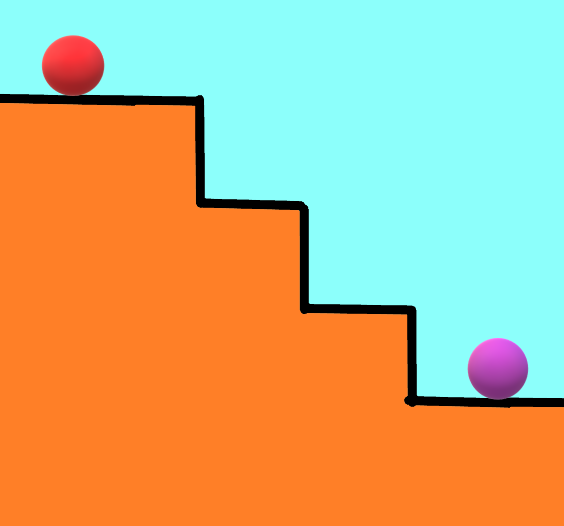In our algebra class, we as a class, created the guidelines to give our own presentation about one mathematical property of our choice. I chose the Commutative Property of Addition. This presentation required two different mediums while having the decision of three. These mediums were, image, sound, and video. For my project I chose to use image and sound. For my image, I drew an example of the property I picked and for my audio, I recorded myself while giving the presentation. With these two mediums, I can give a proper explanation and show my understanding of the Commutative Property of Addition.
My first medium explaining the Commutative Property of Addition is image. For this medium I drew two pictures giving a brief example of the property I chose. In this first drawing there is a purple ball at the top of the stairs and a red ball at the bottom. There are still two balls in total. Just because they are separated from each other does not mean that they are parts of two different equations. In the second drawing there is the red ball at the top of the stairs and the purple ball is at the bottom. The only thing that changed was the location of the balls. They are still part of the same equation and there are still two balls total. This shows the Commutative Property of Addition because the only thing changed in those two drawings was the order of the two balls. The Commutative Property of Addition says you can get the same answer no matter what if you change the order of the numbers as long as you are still adding. In this case, we were still adding the balls together and only changing their position.


The second medium I chose was audio. For this, I decided to record myself while giving the presentation instead of pre-recording it. I have also decided that I would write in here what I will say when I give my presentation. By doing this recording I can show (not only my teacher but other people reading it) that I understand this mathematical property. By saying the basic examples rather than one just reading it on a slideshow presentation, you can really think of other examples that would be related to the property. You don't just think of it as something there on the slide. It is there because even though it might be very simple, it can still mean a lot to the person listening. The Commutative Property of Addition. The definition of the Commutative Property of Addition is: the numbers in an equation or expression can be added in any order and and you will get the same answer. An example of this could be one plus two equal three and two plus one equals three. My first medium was image and I chose to draw pictures to be examples of the Commutative Property of Addition. In this drawing here, there is a purple ball at the top of the stairs and a red ball at the bottom. There are two balls in total. Just because they are separated from one another does not mean they are part of different expressions. In the second drawing the red ball is at the top of the stairs and the purple is at the bottom. The only thing that changed was the location of the balls. They are still part of the same expression meaning there is still two balls total. The explanation of this would be: this shows the Commutative Property of Addition because the only thing changed in the drawings was the order or location of the balls. The definition of this property says that you can get the same answer or have the same total in this case no matter what if you change the order of the numbers and are still adding. I would then ask if anyone had any questions which is not necessary to include in this post here. However I was prepared to answer questions if they came up. According to the rubric I had to create two pieces of art or mediums which I did, image and audio. I also wrote a paragraph about each medium and how it relates to the property. I also was required to give my presentation which I am prepared for and create a blog post like this one here. The final part is that my work does not have any writing errors in it. I feel that from the work I have done, I have given a good explanation of the Commutative Property of Addition and can show my understanding with lots of evidence to prove it. If people that are doing a project similar or just browsing, I hope this helps or is useful in any way for you. The process of making piecing this project together took a little time. With the ease of access by using a computer the drawings were not as hard as they would be on paper. Overall I think this project was a good start to my year.
Comments
Post a Comment